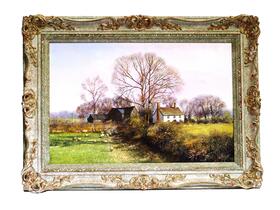Putting Things into Perspective
Putting Things into Perspective
By Elizabeth Talbot
The word perspective has its etymological root in Latin; this origin has associated translations of to “look through” or to “perceive,” and all the meanings of perspective have something to do with looking. Perspective is a concept expressed in many, if not most, languages around the globe; to have a particular perspective is to have a particular way of thinking about something, especially one that is influenced by a person’s beliefs or experiences.
We have all spent the last year studying our various perspectives, including on life and fundamental existence or on the world and its sustainability; on whether to repaint the bedroom or move to a new house to be nearer to loved ones; on whether to remain on an established career path or to follow a dream and try something totally different. We have spent the last 12 months questioning our perspectives, taking time to sit back and survey options and choices or being challenged by newly focused priorities, as they jostled for attention within the restrictions of our curtailed capacity.
Perspective is also the way objects appear smaller when they are further away and the way parallel lines appear to meet each other at a point in the distance. When used as a noun in the context of art, perspective usually refers to the representation of three-dimensional objects or spaces in a two-dimensional form, and artists use perspective techniques to create a realistic impression of depth. It takes great skill to achieve this, but how perspective is understood, represented, and then subsequently treated is a very important concept in the expression of fine art in different periods, because it helps chart various artistic abilities, styles and intensions through history.
Early art did not rely on the use of perspective, because drawn and painted representations captured gods, people and animals in relation to their importance; the largest figure was the most significant, given status by proportionate size, and pictures were literal graphic accounts with a message, rather than true portrayals of what was seen by eye. One has only to think of pre-historic cave paintings or Egyptian art for examples, all of which are unequivocally flat in appearance; and equally, it is a technique used by cartoonists, including our contemporaries.
The Greeks and Romans certainly understood perspective, but their knowledge was lost over time. The art of the Byzantine, Medieval and Gothic periods was rich and beautiful, but the images made no attempt to create the illusion of depth and space, as if it was not even a consideration. The Italian masters Giotto (c. 1267 – 1337) and Duccio (c. 1255 - 1260 – c. 1318 - 1319) began to explore the idea of depth and volume in their art and can be credited with introducing an early form of “primitive” perspective, using shadowing to great effect to create an illusion of depth; but it was not until a 15th Century Italian architect and engineer called Filippo Brunelleschi (1377 – 1446) rediscovered the laws of perspective that progression was achieved. He demonstrated a mathematical approach that proved how forms and space shrink in size according to their location and distance from the eye. Leon Battista Alberti (1404 – 1472) discovered the first theory of linear perspective and published his treatise “Della Pictura” (On Painting) in which he too relied on mathematics as the common ground of art and science. Alberti’s discovery had an enormous impact on European artists, including Leonardo Da Vinci who wanted his paintings to reveal the world as it appeared, and Alberti’s theory is still used by artists, designers and architects today.
To help with the interpretation of perspective, Da Vinci invented a machine called a Perspectograph and then in 1525, German artist Albrecht Dürer published “The Artist’s Manual” which included illustrations of similar perspective machines. The Baroque painters (approx. 1600 - 1750), including Caravaggio, Rubens, Rembrandt, Velazquez and Vermeer, used the system in thousands of varied approaches, as did the Neoclassicist painters (1750-1850). The use of perspective in art to depict reality continued through the works of the Impressionists (such as Renoir, Monet and Pissarro) and was even used in the works of the Post Impressionists, such as Gauguin and Seurat. In the middle of the 19th Century, Vincent Van Gogh used a simple perspective frame with grid lines and adjustable legs while studying in The Hague, with which he quickly and easily translated what he saw onto his paper or canvas.
It was around the time of the Post-Impressionists, however, that a significant change in direction took place. Towards the end of the 19th Century, French painter Paul Cézanne (1839 – 1906) began to question the underlying structure of his subjects. Importantly, he began to ignore the laws of classical perspective, allowing each object to be independent within the space of a picture and letting the relationship of one object to another take precedence over traditional single-point perspective. This is considered a time of rebirth for artistic composition; academic composition following the long-established rules of perspective was well and truly challenged. Heavily influenced by Cezanne, several young artists radically broke the mould and themselves became major influences on 20th Century art.
Meanwhile, mainstream art continues to benefit from the discipline of perspective. A fitting example of linear perspective can be seen in an oil painting by Clive Madgwick, to be sold in The Gallery Sale at TW Gaze on Thursday 6 May. The dominant aspect of the hedge and the configuration of the farmhouse and barn lead the eye through the composition with a true view of perspective, giving a gauge of both distance and scale which adds to the convincing realism of the art. Madgwick (1934 – 2005) was born in Surrey, studied at Guy’s Hospital in London and joined the RAF as a dentist. In 1965 he left the RAF to work at a dental practice in Sudbury, Suffolk. Whilst in Suffolk he suffered a serious bout of glandular fever and began sketching and painting local houses during his time of recouperation. His wide-ranging work became very popular; he exhibited in numerous galleries in and around East Anglia and he became a member of several important art societies. Clive Madgwick’s paintings remain collectable: this example of his work, entitled “Winter Shadows”, carries a pre-auction estimate of £500 – 800.
For a full catalogue and further details of this and other lots in a vibrant calendar of forthcoming auctions, see twgaze.co.uk.

